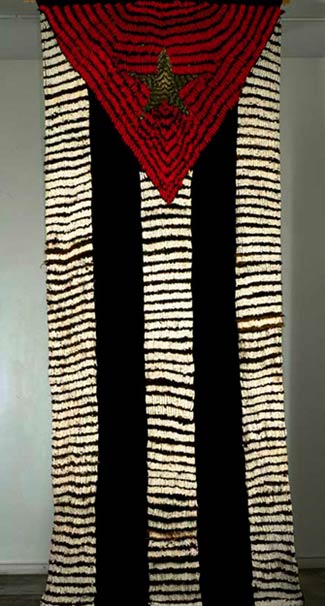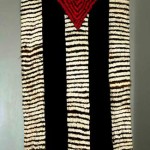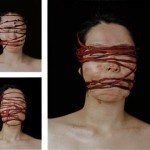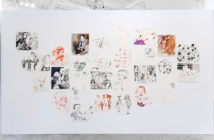By AMANDA SCHMITT
Feminist art is a heavily argued topic in countless critiques and conversations around the art community - How do we distinguish between feminist art, art made by women, art about women, and art with a feminine quality. Why is it that most art made by women, with a feminine quality, is labeled feminist? A piece of art made by a man can be feminine (i.e., pink, frilly, sewed, crocheted), but is it possible for a man to create a feminist piece of art? This summer the Brooklyn Museum takes a look at how feminism has become a major trend found it art all around the world, and treats it as a global issue. It occurs in every country around the world, and sometimes it seems to make a stronger impact when a woman lets her voice out visually, rather than manifested through writing.Global Feminisms presents an impressive collection of present & future feminist artwork by women artists born since 1960. The first wave of feminist art (that is, was labeled as an artistic feminist movement) emerged during the 1970s, but this exhibition showcases only work made since 1990 - an investigation into what represents the feminist art theory today. The show is divided into four themes: life cycles, identities, politics, and emotions. "Life Cycles" takes a look at major milestones in a woman's life: childhood, puberty, sexual development, marriage, birth, nursing, age, and death. Artists question their roles in society as women in the "Identities" section, while others see themselves playing a larger role in the "Politics" section. The "Emotions" section examines fear, love, happiness, pleasure, anger, and other sentiments experienced in the life of a women, as well as a man. The entire show is built around Judy Chicago's The Dinner Party, as it recently found its permanent home at the Brooklyn Museum this year.
A major theme in feminist art has involved an attempt to "take the body back" from the male's gaze. In effect, there are many representations and interpretations of the body, mostly female, in this exhibition. Jenny Seville's Fulcrum is all about the body: the enormous canvas just barely fits the three mammoth female bodies stacked on top of one another inside its parameters. The artist mastered the pale peaches, mute blues, and deep reds of the bodies with oil paint, and renders the painting with an intense sensation of fleshiness, and of the weight of the bodies piled together. Rather than beautifying the bodies, Seville emphasizes their grotesque nature. The photograph Venus Baartman by Tracey Rose, is a celebration of the female African-American body, emphasizing its strength and beauty rather than objectifying it, like men did with the original Venus Hot'n'Tot in the early 19th century, whose voluptuous curves were viewed as a freak show.
The "Emotions" section of this show consists mostly of video installations; maybe this was the best way to get their message across, but it surprises me that, being artistically creative, more of the show's participants weren't able to get an emotional message across visually. Although most of the artworks do emit an emotional resonance, including the paintings, sculpture, and photography from other sections. Of note in the "Emotions" section is Love, a video-montage by Tracey Moffatt of joyous, ecstatic, love scenes from various classic romance films that quickly change into scenes showing the other side of love's emotions: that of anger, jealously, and rage. The words coming out of these timeless characters' mouths seamlessly transition from "you're beautiful" to "you whore." The video bitterly observes the up and downs of the wonderful/terrible emotion of love.
The most interesting sections of this show and also the only sections containing clear feminist - or feminine - work are "Life Cycles" and "Identities." "Identities" concentrates on how different women artists in this show view themselves, and their roles within their family, friends, community, and society. There are several photographic pieces where the artist is commenting on the physical appearance of a woman: Cass Bird's I Look Just Like My Daddy is a simple image an androgynous looking child - it is not clear if it is a photograph of a boy or a girl. Oreet Ashery dresses up in her alter ego of an Orthodox Jewish man, although she exposes her breast in order to reveal that she is a woman, as seen in Self-Portrait of Marcus Fischer I. Latifa Kahch modestly poses in a sexless outfit with an expressionless face in her Pin-Up (Self-Portrait). Julika Rudelius captures an ironic juxtaposition the typical stereotype that women are narcissistic and obsessed with their appearance in her video installation, Tagged. She documents a group of young men trying on their newly bought, designer label clothes while they talk about the brands they like, how much they spent on their designer clothes, and how important their appearance is to them. This piece shows how both men and women worry about their looks, and how physical appearance may affect their identities.
Of the four themes in the show, "Politics" was the smallest and the least interesting -a feeble attempt to round up the number of the sections. All of the works contained a political message, but none of them were clearly feminist, they were not even clearly personal. However, the artists may have seen a reflection of themselves through a bigger, societal picture. One of the walls is covered with what appears to be a simple wallpaper design, but with a closer look, Parastou Forouhar's Thousand and One Day reveals that the tiny, delicately rendered figures are participating in torturous acts of violence. These acts that took place in Iran illustrate scenes such as Forouhar's parents' assassination by the Iranian Secret Service, making this work both deeply personal and political, but not feminist. On another note, Rebecca Belmore's video/performance, The Named and Unnamed, is an example of why many associate negative or annoyed connotations with performance and/or feminist art. Belmore performs on a street corner in an area of Vancouver where nearly 50 women have been abducted. During an overdramatic, I-am-woman-hear-my-voice performance, the artist proceeds to scream out names that are written all over her arms, while eating thorned roses, with no lack of theatrical pauses for suspense. This piece earns an "over-the-top feminist" stamp, along with Priscilla Monge's Room for Isolation and Restraint, in which she creates a solitary room insulated from top to bottom in sanitary napkins.
As a whole, these pieces work together to create an exhibition about feminism, but many individual artworks do not immediately jump out as a feminist piece. The exhibition is jam-packed with talented women artists, with a variety of styles, approaches, and media. The show is tolerable, without too many in-your-face feminist pieces. In fact, if anything, this exhibition shows that feminism is not limited to issues exclusively about women. In the future, it may not just be women giving birth and maternally tending to our children: Hiroko Okada imagines pregnant males in Future Plan #2, and Patricia Piccinni realistically depicts a female baboon nursing a human infant in Big Mother. Feminist art today is not as radical, or harsh as it had been originally in the '70s; Global Feminismsshows that feminist art no longer requires spreading blood all over your body, burning bras, or imagery that looks suspiciously like female genitalia. It varies upon the artist whether they take a soft-hands or a harsh approach into getting their message out, as is the same with all art. The exhibition acknowledges that we can move past the stereotype that harsh, aggressive styles define the modern feminist perspective.
- Tania Bruguera, Statistic (Estadistica), 1996. Textile, human hair of anonymous Cubans, thread, and fabric.
- Ingrid Mwangi, Static Drift, 2001. Two chromogenic prints mounted on aluminum.
- Ryoko Suzuki, Bind, 2001. Lambda print.
"Global Feminisms" is on view March 23–July 1, 2007 at The Brooklyn Museum.
All images are courtesy of the artist and The Brooklyn Museum website.







